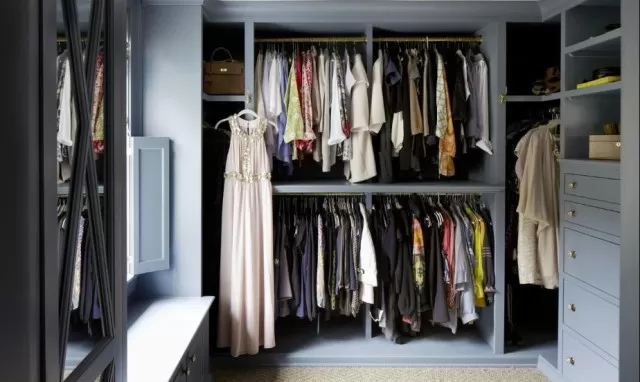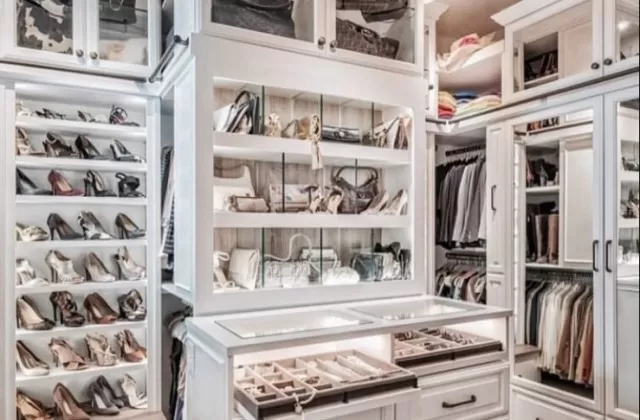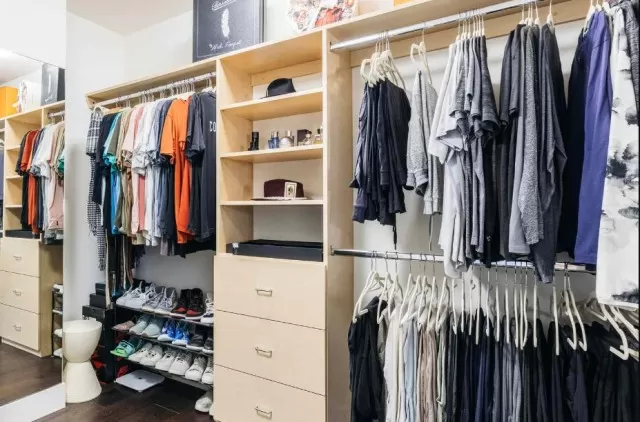If you don’t have helpful ideas for organizing your walk-in closet, you may end up wasting the benefits of having all that space.
A poorly planned walk-in closet can result in lost items, damaged shoes and handbags, and cluttered floors and shelves.
Additionally, you’ll spend valuable time searching for things that may have been haphazardly placed and now require ironing or repair.
The great news is that numerous walk-in closet organization ideas can ensure your clothes, shoes, and accessories are well-organized.
We will guide you on customizing your closet to suit your specific needs and making the most of every available inch of space. With clever organizing solutions and space-saving techniques, your walk-in closet will become your favorite place to enter.
What is a walk-in closet?

A walk-in closet is a spacious storage area designed to accommodate individuals walking inside to access and browse through their belongings.
Unlike traditional closets, which are typically smaller and require reaching in from the outside, walk-in closets provide enough room for a person to enter and move around comfortably. They are often designed as small rooms within a home, featuring wall-mounted cabinets, shelves, and drawers for organizing clothing, shoes, accessories, and other personal items.
Walk-in closets can be customized to fit individual preferences, and they may include various storage features such as doors (such as sliding doors) or open shelving systems. The larger size and convenient layout of walk-in closets offer increased accessibility and make it easier to organize and maintain a well-structured wardrobe.
Walk-In Closet Ideas for Organization & Storage

Discover our top tips on how to effectively organize a walk-in closet and make the most of its potential.
Enhance the Boutique Ambiance.
Transform your walk-in closet into a luxurious haven that resembles a high-end boutique.
Embrace the space by adding stylish elements such as vibrant wallpaper, a plush seating area, and an elegant ornate mirror. These touches contribute to creating a beautiful and serene environment.
To give your closet a boutique feel, arrange your shelves in a visually appealing manner, alternating between displaying your shoes, hats, and bags. When you take pride in the aesthetic appeal of your closet organization, you’ll be more motivated to maintain its order.
Moreover, think of your closet as a personal getaway within your home—a sanctuary where you can relax and enjoy the process of getting ready for the day ahead.
Opt for a Custom Closet System.
Upgrade your average 8×10-foot closet with a custom closet system, readily available at local home improvement centers.
Installing such a system can be done over a weekend, providing you with a quick and convenient solution. Choose from a variety of drawers, clothes rods, and shelves that suit your needs and maximize your space utilization.
Additionally, customizable accessories like modular drawer dividers and shoe storage options can greatly enhance the organization of your walk-in closet. Consider incorporating a small charging station within the system for your cell phones and tablets.
Categorize Folded Items.
Streamline the storage of folded clothes in your walk-in closet using wire organizers.
These organizers not only optimize space but also allow your clothes to breathe, reducing the chances of mold or pests. Many wire shelving systems offer snap-on shelf dividers that enable you to sort your clothes more effectively.
Remember to group similar items together and ensure that your stacks of folded clothes do not exceed one foot in height to prevent them from toppling over.
Make Use of Every Inch.
In your walk-in closet, it’s essential to maximize every square inch of available space, especially if you share the closet with a partner or roommate.
If you’re already utilizing a double-hang rod and have introduced compact shoe storage while keeping your tops neatly folded on shelves, don’t forget to utilize the upper areas. The top shelf, typically located above the top rod, can be used for storing items that you rarely use, such as special occasion bags, holiday sweaters, off-season clothes, or shoes.
Labeled bins or boxes can be placed on this shelf, creating an organized and easily accessible storage solution. Consider adding a small step ladder to your closet for reaching these items whenever needed.
Incorporate a Hamper.
Where clean clothes reside, dirty ones are often found nearby in a chaotic mess on the floor.
Simplify laundry day by adding a hamper to your walk-in closet. Choose a portable hamper with handles or wheels, or opt for an over-the-door design to save floor space.
A divided laundry bag allows you to presort your items before washing, streamlining the process and keeping your closet tidy.
Optimize Shoe Storage.
Did you know that the average woman owns 40 pairs of shoes? When deciding on how to store your shoes, start by taking an accurate inventory of your collection.
Walk-in closets offer various shoe storage options, ranging from small cubbies to spacious pullout shelves. It’s important to keep your shoes visible, sorted, and easily accessible, as this encourages an efficient morning routine and simplifies cleanup.
Consider storing slender shoes like flats and flip-flops two in a cubby, placing tall boots on high shelves when they’re out of season, and using boot trays on the floor for frequently worn boots. Another option is to use a tall, glass-front cabinet that keeps your shoes in one convenient place while allowing you to easily see and select your desired pair.
Acrylic shoeboxes can be stacked on shelves or placed on the floor, while over-the-door and hanging shoe organizers are great choices for freeing up floor space and utilizing vertical storage.
Plan for Accessories.
Accessories come in various shapes and sizes, necessitating a personalized storage system to accommodate them all.
If your walk-in closet doubles as a dressing area, consider creating a small vanity space complete with a mirror for a convenient mini grooming station. Use a jewelry tree or jewelry box to keep your accessories organized and easily accessible.
Drawer organizers offer another practical solution for storing jewelry while keeping them out of sight if desired. Hang purses neatly on hooks or hangers, and utilize shoe cubbies for storing small clutches.
Seasonal items like scarves, gloves, and hats can be placed in lidded bins. To save time searching for specific items, use adhesive storage labels throughout your walk-in closet.

Prioritize Customization.
When selecting a closet system, prioritize choosing one that can adapt and grow with your evolving needs.
Opt for track systems that allow for easy adjustments or additions in the future as your wardrobe or lifestyle changes. When initially designing the closet, ensure it is not overcrowded, leaving some room for your existing items to breathe.
As you acquire more belongings or experience lifestyle changes, such as a new job that requires daily professional attire, you can comfortably add more shelving and space to accommodate your expanding collection. Consider investing in quality hangers, such as velvet clothing hangers, to further enhance the customization and organization of your closet.
Utilize Blank Wall Space.
While most wall space in a walk-in closet is occupied by hanging clothes and shelves, you may occasionally find a blank wall that can be converted into additional storage.
If you have open wall space, utilize decorative hooks to hang your frequently worn accessories like hats, bags, and scarves. Below the hooks, place a narrow console or shelf to hold smaller items such as sunglasses and jewelry.
By installing a set of hampers underneath the console, you can maximize the storage potential of your walk-in closet.
Lighting is often overlooked when planning a closet makeover, yet it plays a crucial role in accurately perceiving colors.
Opt for a ceiling-mount light that provides ample illumination in your walk-in closet. Additionally, consider using lamps as supplementary lighting options.
If your closet features a window, installing a light-blocking shade can offer privacy and prevent clothing items from fading due to excessive sunlight exposure.
Store Large Items.
Make use of out-of-the-way spaces in your walk-in closet to store larger, bulkier items that may not easily fit elsewhere.
Designate a high shelf or two specifically for items like carry-on suitcases or weekend bags. This way, you won’t have to make frequent trips to the attic or basement when you need to pack for a quick getaway.
Instead, you can conveniently access these bags within the same room by simply reaching up and retrieving them.
Establish a Clothes Care Section.
With additional space in your walk-in closet, consider dedicating a basket or drawer as a designated fabric care section.
This section can house essential items such as steamers, irons, sweater shavers or stones, lint rollers, stain removers, a sewing kit, and shoe polish and brushes. Having these items readily available in one spot ensures that you are prepared for any wardrobe emergencies.
Consider including an eyeglass repair case, extra shoe laces, or heel caps within this kit, providing a home for items that might otherwise get lost in a cluttered drawer.
Plan Your Outfits.
Most walk-in closets feature multiple sections for hanging clothes, combining short and long lengths.
Dedicate a small section to prepping your clothes for the week ahead. Create or print out labels and attach them to dividers for each day of the week.
Then, choose your outfits and hang them behind the corresponding dividers. This simple step eliminates the stress of deciding what to wear on busy mornings while keeping your clothes organized and readily accessible.
Install a Double-Rod Organizer.
Make the most of your closet’s vertical space by incorporating a double-rod closet organizer.
This allows you to maximize the height of your closet effectively. Use the upper bar to organize shorter clothes like blouses and tank tops, and utilize the lower bar for pants and skirts.
To minimize wasted space, designate an area, such as the end of one bar, specifically for empty hangers. Additionally, reserve shelf space for folded garments like T-shirts and sweaters that don’t necessarily need to be hung on a closet rod.
*The information is for reference only.